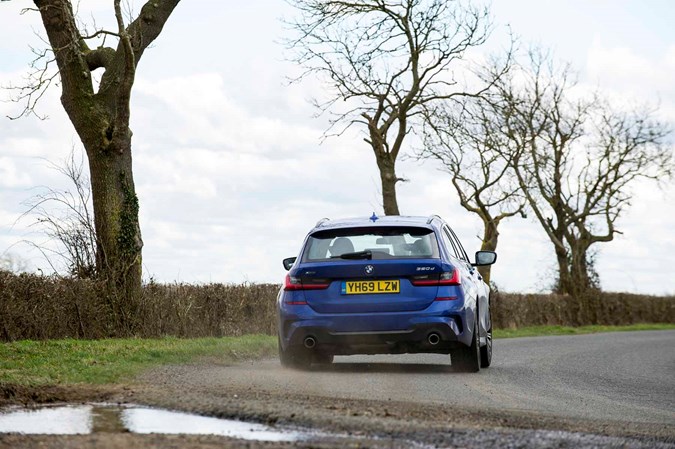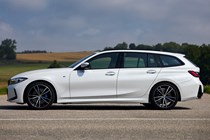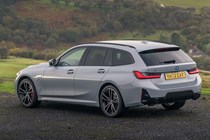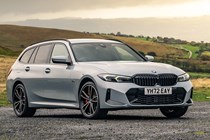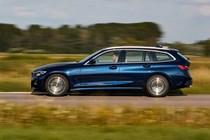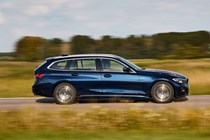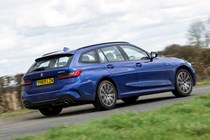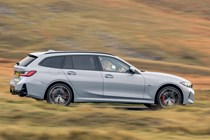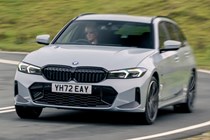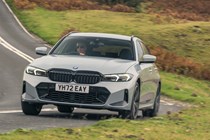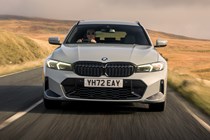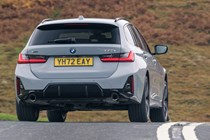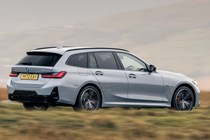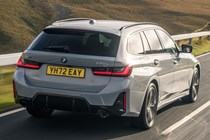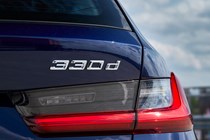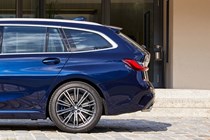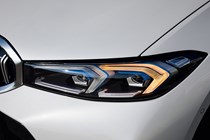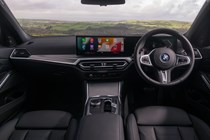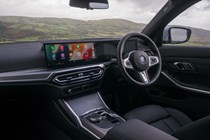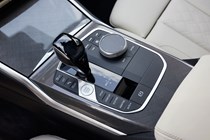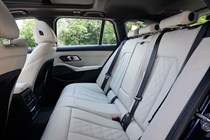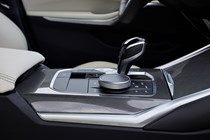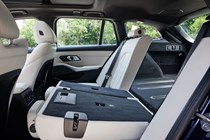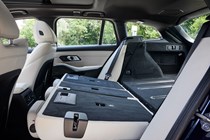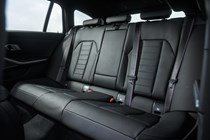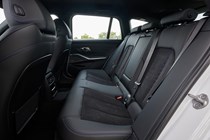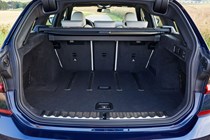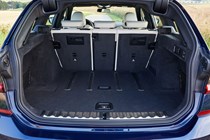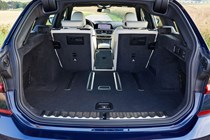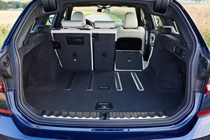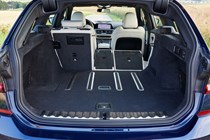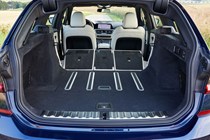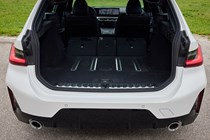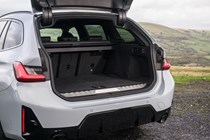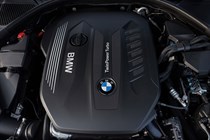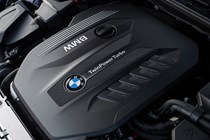
BMW 3-Series Touring long-term test
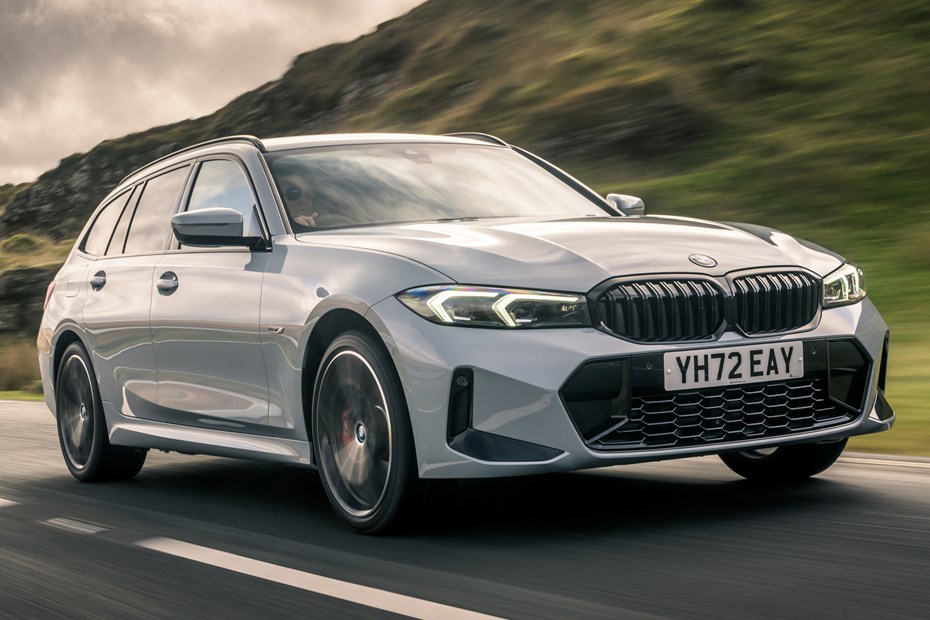
Update 1: Welcome
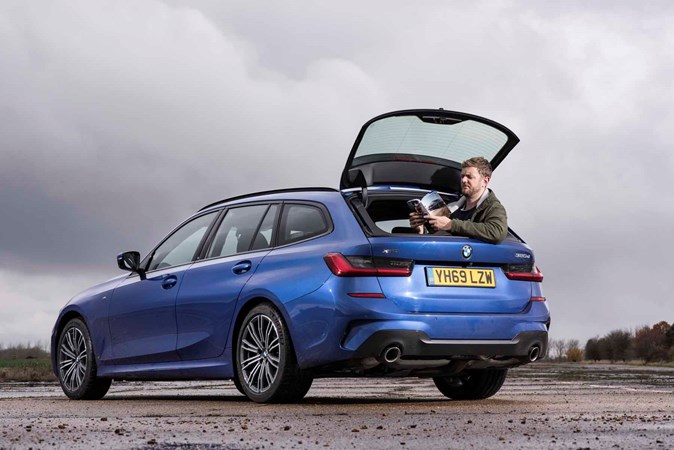
Parkers new cars editor Adam Binnie takes charge of BMW’s brilliant family estate car…
Believe it or not, a large number of 3 Series Touring drivers polled by BMW did not know that they could open the glass section of their boot separately to the rest of the tailgate. It’s designed to carry long items or so you can lob something into the back of the car without waiting for the whole thing to open.
It seemed to me therefore like the perfect place to relax with a copy of the user’s manual to find out what other features of this car its owners may have missed.
Things like the grippy rails on the boot floor that drop away to allow easier sliding of items, and pop back up to hold onto them when you set off, or the equally ingenious proximity sensing door locks – these automatically secure the car when you walk away, and unlock when you approach. No need to wave your hand near the handle like other keyless systems.
Best of all though are the heated seats that can be set to activate when the outside temperature is below a certain level. I’ve got them set to 20 degrees (the maximum allowed) to ensure they’re basically on all of the time here in the UK.
The point I’m (taking a long time) getting to is that this is a very clever car, packed with lots of intelligently thought-out solutions to problems you never knew existed. Often little things that you could live without – it’s not hard to press the heated seat button – but added up they make for a much nicer experience.
There’s a reason for this cleverness, and it’s because the BMW 3 Series is a bit like the VW Golf – both are the product of decades of whittling – with each generation leaving behind what doesn’t work and improving what does.
That means the 320d is arguably all the 3 Series you need unless you want an M3. Models in between, as nice as they may be, are not as well-rounded as this model because it offers just enough of everything – power, refinement, economy and luxury. Especially for company car drivers.
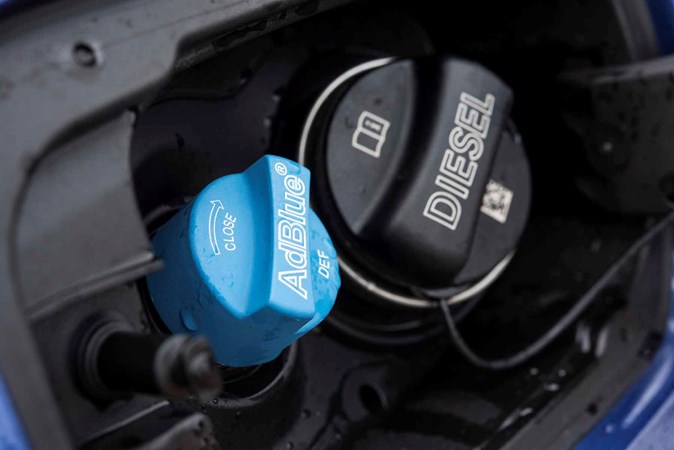
Not been faced by an AdBlue filler for a while
That’s why you see so many of them – if you spot a 3 Series on the motorway, chances are it’s the very 2.0-litre diesel model we’ll be testing over the next three months. It’s also probably been debadged, despite the 320d nameplate being just as iconic as the vRS or T5 badging on my previous long-termers.
If you’ve paid attention to my last three cars you’ll know they’ve all been 2.0-litre turbocharged petrols. Don’t get me wrong, it’s been a fun ride, but 18 months of sub-30mpg fill-ups have left me pining for a 500+ mile fuel tank, the likes of which you’ll only get in a diesel (unless you’re able to keep plugging the car in).
The first few hundred miles have already returned close to 44mpg – perhaps not as high as you were expecting, but bear in mind this is an xDrive model, which means it has all-wheel drive. That knocks the fuel economy down a few rungs, but also makes it the ideal alternative to the Audi A4 Avant with its fancy Quattro all-wheel drive system.
I’ve previously run one of those, so will be keen to find out how the BMW’s promise of the Ultimate Driving Machine stacks up in the handling stakes now it’s sending power to all four wheels. Early indications are good – while the A4 handled every corner in the same fashion, by sticking relentlessly to the tarmac, you can move this car around a lot more with the steering and throttle and feel more involved in the process as a result.
Match that with a big, practical boot, ample room for my family and a tow-bar to hang my bike off, and I think we’ll get on.
Update 2: Practicality and safety
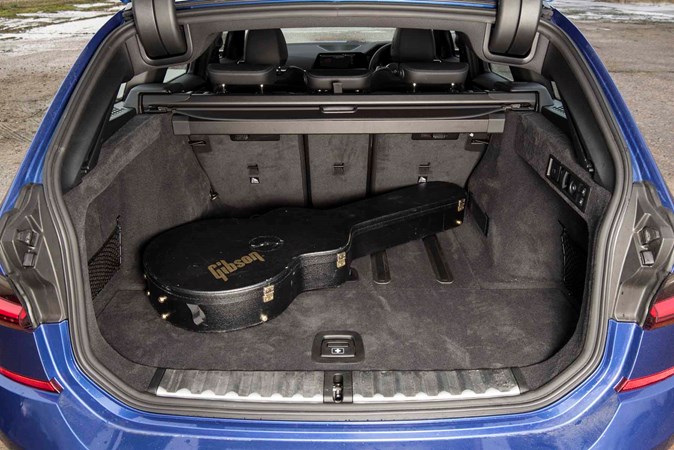
The whole point of the BMW 3 Series Touring is the additional practicality it offers – you buy this car because you like the way the saloon drives, but you need additional space.
In theory then, pin-sharp handling is the priority, so this estate doesn’t necessarily need to better its rivals when it comes to boot or rear passenger space, it just needs to be competitive.
The trouble is, few cars these days are actively bad to drive, so this generation of 3 Series Touring has had to up its every day appeal to keep pace overall with things like the Audi A4 Avant, Mercedes C-Class Estate and Volvo V60.
Does it?
Yes – this model is 76mm longer than the previous car and has an extra 41mm between the front and rear axles to unlock more passenger space. It’s also wider and taller, and if you choose a panoramic roof like our car (part of the £1,900 Premium Pack) a newly designed electric blind means it doesn’t eat into headspace so badly. I fit fine and I’m 6 foot 3.
In terms of storage up front there’s a curious small drawer below and to the right of the steering wheel, which I guess is useful for parking change or maybe a small stash of sweets. You get more room in the door pocket, which has a round section for holding onto a bottle too.
A larger space in front of the transmission houses two cup holders, a normal USB socket and a wireless charging pad (part of the Tech Pack – £1,900). Fascinatingly this is the exact width of my phone. I’m not exaggerating – it fits in with about three microns of space either side, which is extremely satisfying. There’s a lid too, making the cabin look neater, and also means you can hide your phone away without it distracting you while it’s on charge.
Underneath the driver’s left elbow is an armrest (it has no height or fore/aft adjustment but it does seem to be in exactly the right spot) and if you open this there’s a large but not particularly deep box, about the size of a big bag of crisps. This has a single USB-C socket, which is becoming the norm of car interiors now.
What about the back seats?
There are two USB-C sockets in the back, too, which means your passengers will need to make sure they’ve got a charger cable that is compatible. You can get a little adapter that goes from normal, rectangular USB to USB-C, so it might be worth investing in a pair if you regularly convey people in the back.
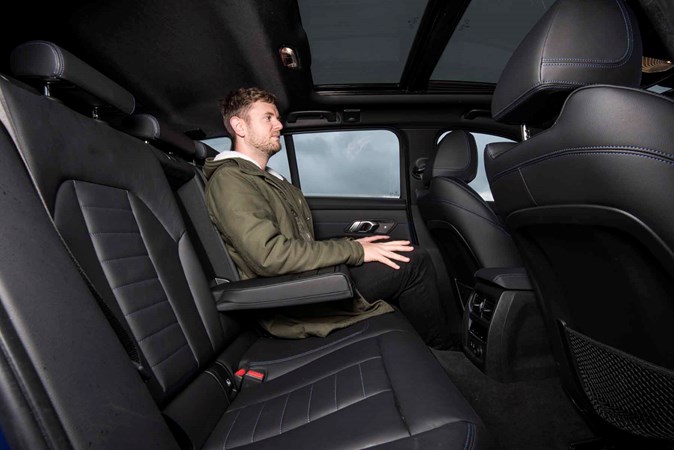
The door pockets are also smaller but sectioned off like those in the front, so you can still get a big bottle in them, plus there are two cupholders in the armrest and a net on the back of each seat large enough for an A4-sized magazine.
The rear seat space is good with lots of legroom and headroom despite the panoramic roof (this ends just in front of the rear passengers’ heads so doesn’t compromise space) and there are little tunnels to access the Isofix mounting points, which are very useful.
Does it have a big boot?
Another growth area over the old car is the luggage space, with 500/1,510 litres with the seats up/folded – marginally more than the A4 or C-Class but less than the VW Passat Estate or Skoda Octavia Estate. The Volvo V60 I previously ran had 529-litres of space.
While it’s not as big as that car’s, BMW has made some helpful revisions, such as making the opening 125mm wider and squaring off the usable space. That means while there’s only five litres difference between this car and the last model in terms of total boot space, the main area is actually 32-litres larger. In reality it feels more of less the same size as the Volvo’s.
Elsewhere there are two sections of net to restrain loose items, buttons to collapse the rear seats, a hook and a 12v socket. There’s even space under the boot floor to store the load cover and mesh load barrier.
This can be installed either between the seats and boot so you can pack the whole back of the car out without it spilling onto your passengers, or between the front seats and load bay when you’ve got the back seats folded. Simple, but very handy, and means you can make the most of the space.
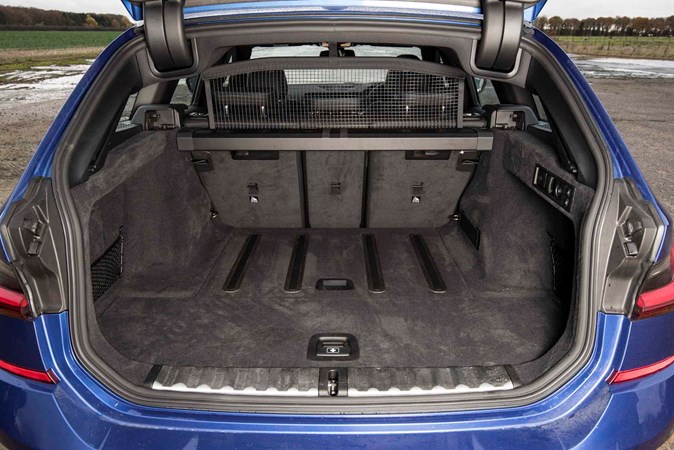
The boot lid is powered as standard, while our car has a hands-free function (part of the £890 Comfort Pack), which is very useful when you have your hands full, but it has tried to eat my wife’s head several times. You trigger the mechanism by waving your foot under the rear bumper, so if you stand too close to the car while loading the boot it can close it by accident.
As I pointed out in my last update the glass section itself opens too via a button at the base of the rear wiper. Very handy when there isn’t a lot of space to open the whole tailgate or when you want to just chuck something in quickly.
In the floor I’ve got four special rubber and metal strips – these make it easy to slide heavy items in, and when you close the tailgate the gripper material rises up to hold onto whatever you’ve put in the boot. I can’t decide whether this is brilliant or massively over-engineered. Maybe it’s a bit of both.
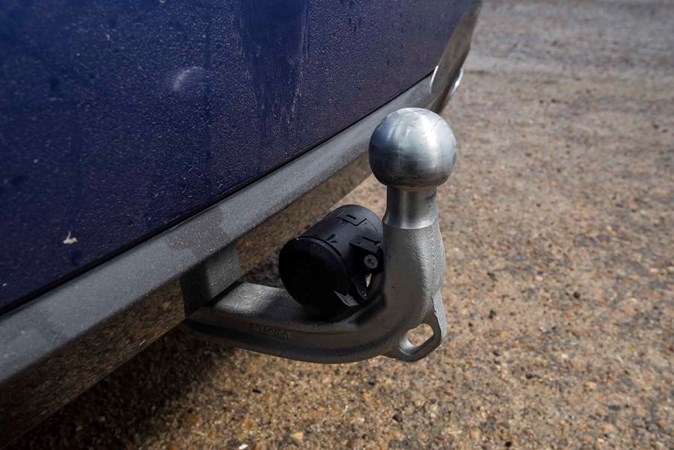
Finally I’ve got an £850 folding towbar – this is 100% powered so all you have to do it press the button to make it pop out or go away, unlike the Volvo V60 I ran previously, which had to be located into place by hand. As it’s a 320d automatic my car can tow 1,800kg – although I only use it to transport bikes.
Safety
While the 3 Series Touring doesn’t have its own specific Euro NCAP score, the Saloon has a full five stars, including a near perfect 97% rating for adult occupants.
It’s fair to assume most of that car’s passive safety performance is carried over into the Estate, which also benefits from loads of driver assistance tech too. Our car has a front collision warning system, which warns you when it thinks you’re going to crash and can intervene by braking if you don’t respond. This has three sensitivity settings if it feels like it’s interfering too much.
The same goes for the lane departure warning, which vibrates through the wheel when you wander left or right in your lane, and car even steer you back in a straight line. This can be adjusted with three settings and the steering assist disabled. To be honest I’ve turned this off – it’s fine on the motorway but can be a bit intrusive elsewhere.
A speed assistant picks up traffic signs to make sure you know how fast you should be going, and can even adjust the cruise control automatically when the limit changes. All around parking sensors and cameras (Parking Assistant Plus, £650) help you navigate at low speed, but there’s also a cross-traffic warning if something wanders across the back or side of the car, at which point it’ll chuck the anchors on to stop you hitting it.
There’s even a 3D panorama view, which uses GPS and camera data to superimpose a to-scale image of your car and the surrounding area on the screen. It’s quite weird to look at, especially because the car is the correct colour (although this digital version has larger wheels, which is a bit annoying) but when you get used to it, it’s actually incredibly helpful for avoiding obstacles when the view out of the windows is compromised.

To this end you also get a camera that helps you dock the towbar and another for lining the front wheels up with a car wash. Oh, and the birds-eye view also shows you where the extremities of the doors are and whether there’s enough space to open them fully.
Thing is, all of this would be useful if the 3 Series Touring was hard to see out of, but it’s not. There’s loads of glass and massive rear-view and door mirrors (these are heated, power-adjusted and auto folding) rear headrests that not only tuck down out of the way but actually fold horizontally to maximise your view out the back.
The low dashboard and screens means you can see the whole bonnet and road in front of you, but does at times make the dials feel a little low-set. This makes the head up display (Tech Pack, £1,900) seem pretty essentially, as it means you don’t have to take your eyes off the road.
So, if you’ve got this far and want something of a concise conclusion – yes the BMW 3 Series Touring is very practical and in theory very safe too.
Unsurprisingly those are two things I prioritise, especially when going on a long trip like the one during the festive season in 2019. With the luggage divider net deployed between the boot and back seats (like the picture above) I was able to make use of the entire boot. That’s largely due to the fact you can keep the tailgate itself shut and pack the boot to the roofline through the opening glass section.
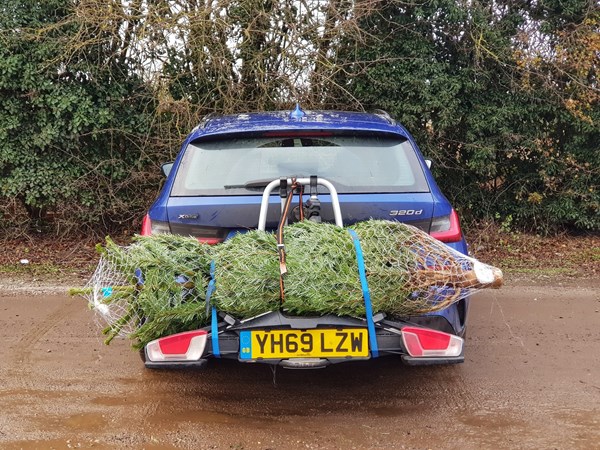
It basically turns the back end of the 3 Series Touring into a pick-up truck of sorts, and means I could get way more in there than even in the larger-booted Volvo V60. Plus, I found an even more satisfying use for my bike rack. No hoovering out pine needles for the next three months for me!
Update 3: What’s it like to drive?
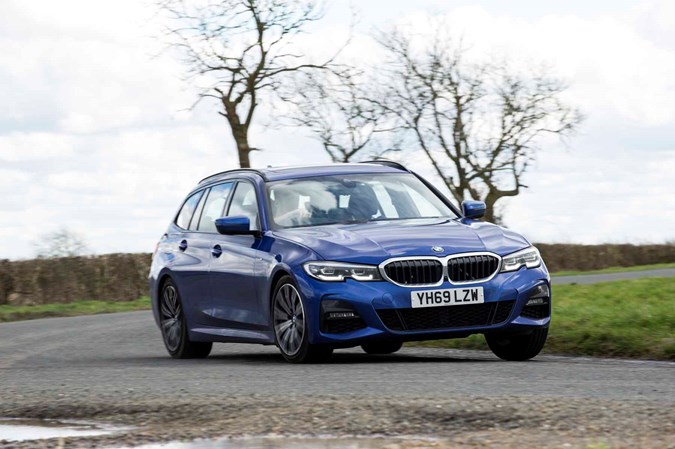
As I said previously the 320d is a proper do-it-all car, with middleweight power and performance balanced neatly against economy and purchase price. It has just the right amount of everything.
Perhaps the best way to show this is with *adopts nerdy voice* a table showing the 3 Series Touring engine range, highlighting how well positioned the 320d is. I’ve put this at the bottom of the update so I don’t immediately lose your interest.
The 318d might be more efficient but it’s over a second slower from 0-62mph, while the 340i is faster but at the cost of a serious petrol thirst. Our car sits happily in the middle offering a good amount of both. It’s so middle-of-the-road it should have cat’s eyes on it.
The 330d makes a pretty strong case for itself if you want more performance without sacrificing too much in the way of economy (less than 10mpg) but the bump up in CO2 will make it a tough sell for some company car drivers.
More interestingly, if you ask me, is the cheaper, faster, lighter, more efficient and (in theory) more involving two-wheel drive 320d. On paper it’s better in every department than our all-wheel drive car – except for outright grip of course.
Why get xDrive at all then?
Well that is the question isn’t it? There’s certainly the all-weather argument – I’ve had zero issues in pulling away or cornering in the pouring rain, and while we haven’t had snow (yet) I’d feel much happier in this car than the rear-wheel drive version, winter tyres or not.
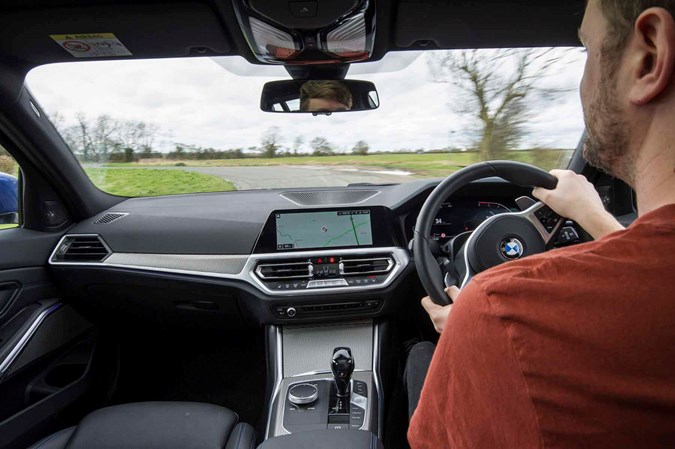
If you want a car that remains stuck to the tarmac in all conditions but still offers a degree of driving fun, then the xDrive makes perfect sense. It’s certainly more involving than my old Quattro-equipped Audi A4 Avant, that’s for sure. And actually, while I like a twitchy, on-the-limit rear-drive car when I’m driving by myself, I want the exact opposite when my family are on board.
Providing something of a compromise between boring and drifty is this xDrive BMW – it has so much grip it honestly feels like the only way you could get the tyres to let go of the road would be to corner so hard you roll the thing over.
What’s nice is that it that the grip feels very neutral, in that both the front and rear tyres feel like they have the same amount, up until the point where it starts to run out. Only at that point does the xDrive system start to feel a bit rear-biased.
You might be wondering what this means or why it’s a good thing – well, my old Audi A4 was the opposite, so when it started to lose grip the front end would wash out first. This is safer than the rear of the car swinging around but it also made it quite boring to drive quickly. Once the front wheels slip your only option is to slow down.
At the BMW’s limit of grip the back end starts to move around, which is more fun, because you can adjust how much or how little it moves with the steering and gas. This balance also means that at lower cornering speeds you can lift off the throttle or brake late into a corner to make the back end step out slightly and point the front of the car into the corner, making it feel alive to your inputs.
Before driving this car I wondered whether it would feel a bit like the BMW M5 – this has a more sophisticated xDrive all-wheel drive system and of course more power. You can push the back end of the car wide in corners by applying more throttle just like a rear-wheel drive car, or you can be sensible and lean on the massive grip of all four tyres. The choice is yours.
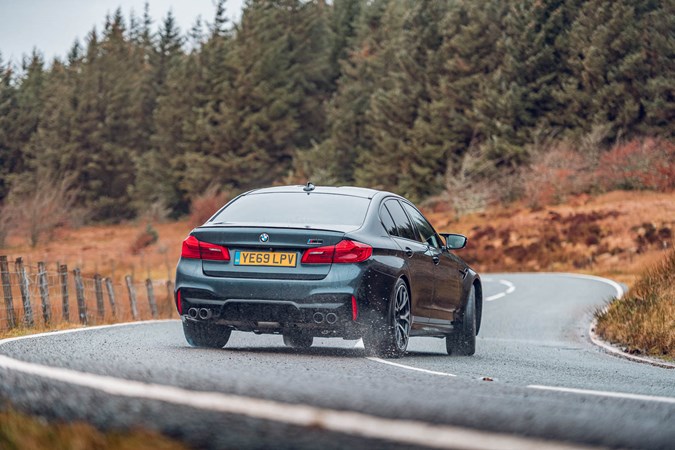
– The BMW M5, significantly more sideways
In truth the 320d xDrive is bit more one dimensional than that – it just grips and grips and feels incredible stable and composed unless you try hard to unsettle it, which is not really appropriate (or even possible most of the time) on the public road. I suspect the standard-issue, limpet-like Michelin Pilot Sport 4S tyres have a lot to do with this – although these are starting to get close to being a bit worn out on the rear after 8,000 miles.
Are you saying it’s underpowered?
Not at all, just that in the greater scheme of things, this is a car with more grip than power. In reality a diesel estate is never going to be as much to drive as something as purposeful as an M5, or even the rear-wheel drive version of this very car, but it’s enough to be entertaining without catching you out in poor weather or when you drive too enthusiastically. For day-to-day use, that means it’s pretty much perfect.
In fact the engine has exactly the right amount of power – enough to make decisive moves on the motorway or get up to speed on a short slip road but not so much that it feels like you’ve got 200hp you never get to use.
Clever turbocharging means you never really feel any delay in the delivery when acceleration, and no massive spike in power from the boost arriving in one big lump like some diesel cars.
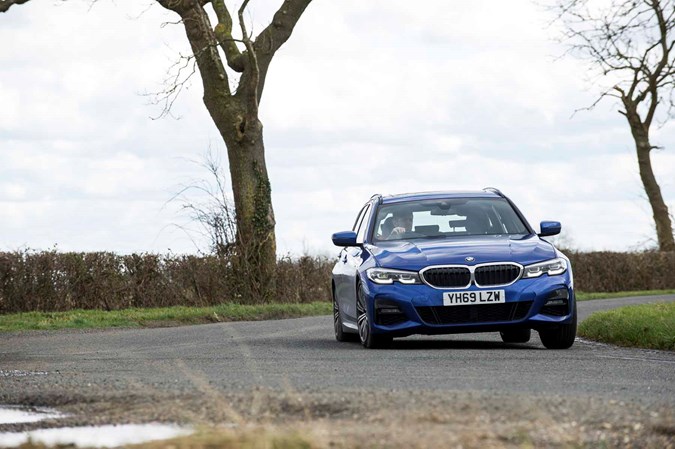
I reckon a lot of that has to do with the gearbox – an eight-speed, traditional automatic that might well be the highlight of the whole car. It’s just so versatile – leave it in normal mode and you won’t feel it working, just a seemingly uninterrupted flow of power.
Move the lever across into ‘S’ and the shifts get quicker and take on a bit of a punch, even more so if you take control yourself using the rubber-backed metal paddles behind the wheel. In reality there’s no need because only in the most extreme circumstances do you need to intervene, it’s really that good.
That said, if you watch the rev counter as you accelerate you’ll noticed it only moves between about three and four thousand RPM – a narrow band where the most linear torque is found. Put it in manual and let the revs drop below 2,000rpm and you’ll find a bit of lag before it picks up, and a slightly breathy top end above 4,000rpm. In short, the automatic gearbox is much better at managing the engine’s power than you.
Any negatives?
There always are – and so often in a reasonably standard BMW the most obvious problem in our car are the brakes. They’re not dangerously underpowered, but they do feel very unassisted. What does this mean? Well normally when you press the brake pedal in a modern car they slow you down almost immediately. This 320d needs a firm press before anything happens, which can catch you off guard, and does nothing for your confidence when driving quickly.
One solution is to stump up £2,200 for the M Sport Plus package, which I recommend you do if you have any ambition of enjoying this chassis at its very best. For that you get beefy M Sport brakes, larger 19-inch wheels plus some cosmetic upgrades, and the very useful adaptive M Sport suspension.
The latter solves the other nagging problem this car has – it’s quite firm riding. There’s a reasonably forgiving amount of travel in the springs for small bumps but this ramps up significantly when you hit anything larger, like a pothole or expansion joint. It’s very composed on the motorway though.
I also think the steering is a bit too light even in its sportier mode, although this is likely to vary from person to person, and it also seems to speed up as the wheel turns, which can leave it feeling a bit unpredictable.
I’ve also found the coast function a bit hit and miss – supposedly when you take your foot off the gas the car should disengage the gearbox and shut the engine down, useful for rolling towards roundabouts or junctions while saving fuel. Sometimes it works, sometimes it doesn’t, and I can’t seem to work out what triggers it.
Let’s finish on a (related) high though – the Eco Pro mode is brilliant. Usually this setting gives you a horrible throttle response, no power and reduced air conditioning function, but in the BMW you can tailor it exactly how you want. I like it because the gearbox shifts up earlier than normal, making an already refined car even more whisper-quiet, without sacrificing engine response or acceleration. What a lovely surprise.
| Cylinders | Power | 0-62mph | Economy | |
| 318i | 4 | 156hp | 8.7 | 39.8-40.9mpg, 133g/km |
| 318d | 4 | 150hp | 8.8 | 51.4-53.3mpg, 114g/km |
| 320i | 4 | 184hp | 7.5 | 39.8-40.9mpg, 133g/km |
| 320d xDrive | 4 | 190hp | 7.4 | 50.4-51.4mpg, 119g/km |
| 330i | 6 | 258hp | 5.9 | 38.7-39.8mpg, 136g/km |
| 330d xDrive | 6 | 265hp | 5.4 | 42.8-43.5mpg, 141g/km |
| M340i xDrive | 6 | 374hp | 4.5 | 33.2-33.6mpg, 165g/km |
Update 4: How does it handle long journeys?
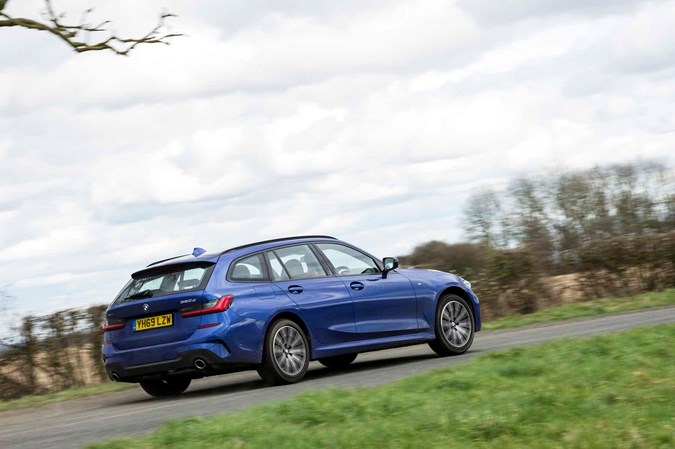
Parkers editor Keith Adams takes over running the BMW 320d Touring…
The BMW 3 Series has been designed, built and honed for the motorway, and although it’s nice that it handles B-roads (above) so well, and it’s blessed with fluid steering and a set of controls that allow a keen driver to really interact with it, how it eats up miles on is what really matters to – I suspect – most BMW 3 Series Touring drivers.
So, with that in mind, it makes sense that we’re testing it over a series of long journeys that accurately echo the typical business user’s weekly grind. It’s worth noting that regular driver, Adam Binnie (above) was the previous keeper of the car, and he’d done a great job with it – finding the BMW handled his commute with consumate ease, while enjoying regular trips to South Wales loaded up with bicycle and family gear.
My use of it is a little different. I enjoy regular trips between work base near Peterborough and home in West Cumbria – and being a 500-mile round trip that encompasses motorways, A-roads and some very challenging B-roads, it gets a proper work-out. Being a 320d, I’d expect great economy, and as Adam said, ‘I get 43.5mpg out of it no matter how I drive it…’ Not too shabby for a 190hp amply-proportioned family wagon. This is going to be good.
Firstly, fuel economy…
My tenureship of the BMW 320d coincided with the strict controls that came with the Coronavirus (COVID-19) pandemic hitting the UK. And what that meant was that for the first eight weeks of this period, I was holed up in West Cumbria with the BMW being used for little more than the odd visit to the local Co-op, and delivering food to some of Seascale’s elderly residents. In that, it was very good indeed. So much so that between the middle of March and the beginning of May I didn’t actually put any fuel in it at all…
Once the restrictions eased a little, and travel became an option between Cambridgeshire and Cumbria, I managed to stretch the BMW’s legs a little. During this period, with the roads so quiet, and a strict adherance to all speed limits, the BMW’s fuel consumption improved markedly. That’s not a comment on Adam’s driving, more a reflection of the quietness of the roads – and the fact that you could leave it to run unfettered on cruise for what felt like hours at a time.
But the result is that in the 2,500 miles I’ve been driving the car, it has averaged 55.3mpg, with a high on one journey of 59.9mpg. As far as I’m concerned, that’s a remarkable result given what a great all-rounder this car is. It also means that the lifetime average fuel consumption of the car has now improved to 45.5mpg. Adam reckons that’s a ‘solid effort’ from me. I’d hardly say it’s been an effort, and certainly not a chore.
What’s it like on the motorway?
Very good indeed, although there’s room for improvement. One nice aspect of running a diesel is the long fuel range you get – something you quickly lose when driving a petrol or EV. I’ve regularly made 600 miles on a tank without trying too hard, and in an era of small fuel tanks and petrols that deliver 35mpg on a run, this is a refreshing change. Especially in times where too many visits to petrol stations are not exactly advisable.
I ran the 3 Series mostly in Eco Pro drive mode, which softened the throttle response and had the eight-speed auto shifting up as early as possible. Acceleration doesn’t seem to suffer too much in this mode, although it’s quite a contrast to the hyper-responsive Sport mode. But this mode seems to work best on motorways, where the engine mostly sits at less than 2,000rpm, and is whisper quiet in the background, with very little wind noise to complement it. Although I’d not recommend it, non-stop 250-mile runs are completed without a murmur.
Ride quality does let the BMW down, though – again, this is down to the large 19-inch wheels and M Sport suspension package. It’s restless and joggly at motorway speeds, and the over-firm seats may have plenty of support, but they are lacking in ultimate comfort. If I were speccing a 320d Touring, I’d definitely steer clear of the M Sport. And that’s a shame, because in every other area, this is one impresive motorway cruiser.
Update 5: How well does the tech work?
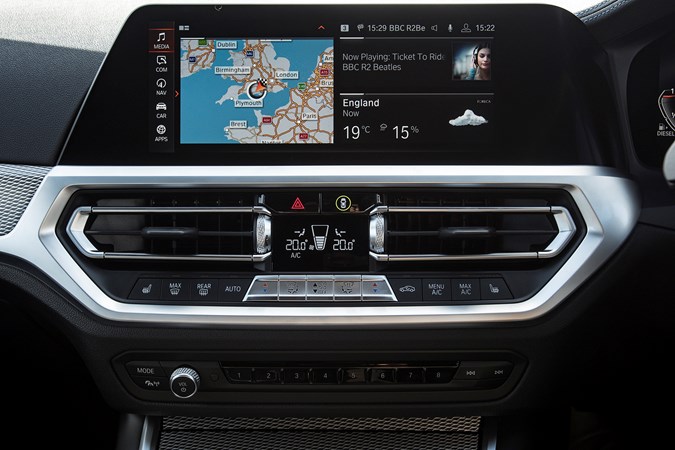
When talking about a car like this, it’s impossible to avoid taking time to discuss the infotainment set-up. Although BMW doesn’t really talk about iDrive anymore, it’s good to see that for fans of older cars with this set-up, the current iteration is familiar enough to not not need a massive re-learning session. But it’s so much more than that – although it’s primarily driven by the large rotary control, you also have a very effective speech recognition set-up and a slightly less useful gesture control system.
When I first picked up the car from Adam, I was disappointed to see there was no support for Apple CarPlay or Android Auto, especially as I began to feel that I was incapable of using anything else. But after a short period or reacclimatisation, it soon became clear that BMW’s infotainment set-up is actually very good, even if it now feels a little old hat compared with the elegantly simple Tesla Model 3 set-up.
Very quickly I weaned myself off CarPlay and learned to trust BMW’s excellent connected sat-nav set-up and easily-navigated menus. BMW’s voice recognition certainly works better than Apple’s or Google’s, and entering destinations feels natural, and rarely requires clarification. Route mapping works well, and diversions are fed in when necessary, displayed through the excellent colour head-up display and are seamless in execution.
Driver assistance systems
Our car was fitted with standard cruise control – none of your adaptive upgrades here – and lane-keeping assistance. Coming from cars with fully adaptive systems, this felt like a bit of a step backwards, but in reality, this system is simple to use via steering wheel controls, and on a long motorway run, it’s nice not spending your time on edge, waiting for the car to react to a phantom object ahead – disappointingly common on all but the best adaptive systems.
A word on the lane-keeping assist system. This is not a sophisticated set-up that leaves you effectively letting the car guide itself – but more of a set-up that steers away from any white line you cross. It’s quite sudden and not at all subtle – but will probably save you from any unintended lane changes when tired. It’s personal preference, of course, but I’d prefer to spec it with BMW’s optional Steering and Lane Control Assistant, which is part of the Connected Drive suite of driver aids. This does a far better job of semi-automous driving – a real boon on those long, non-stop journeys.
Adam has already described the parking assistance system above, but I’ll just add that the automatic braking works really well. I found myself reversing in some long grass near home, and the car pulled up to a suddent halt. Wondering what was behind, and there being nothing obvious on the screen, I jumped out, looked at the rear of the car, and there was a small, but potentially damaging clump of compacted mud and rock. Given it wasn’t picked up by the camera, and was obscured by the long grass, I’d say that’s a win.
So, overall – BMW’s infotainment and driver assistance tech works really well in this car. Better than I’d have expected.
Update 6: Verdict
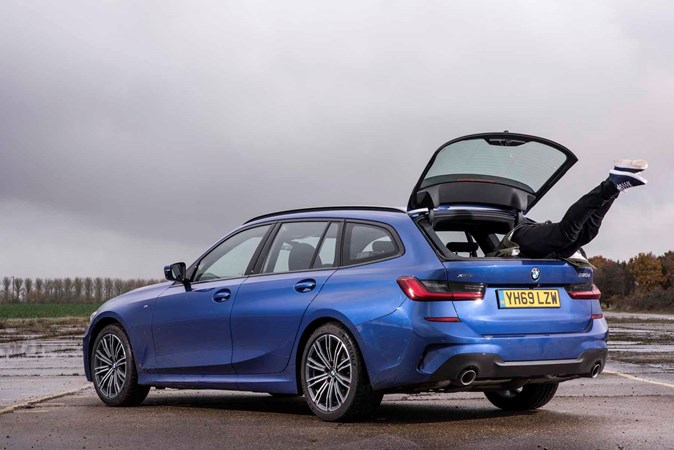
Although our test was extended a little due to to the pandemic restrictions, the end of it came far too quickly. In its time with us, the BMW 320d Touring commanded our respect, if not quite our love. Don’t get me wrong, it’s crushingly, almost ruthlessly competent, and full of some amazingly well-considered design touches, but there seemed to be a little missing magic you’d expect from the ‘ultimate driving machine’.
Adam and I compared notes on what we liked about the 320d and it’s interesting that we were pretty much unanimous on the car’s positives. Firstly, there’s no denying it’s a good car to drive, but Adam concluded, ‘I liked the way it drove but found that all-wheel drive system a bit too grippy for the engine.’ I know where’s he’s coming from on that, and wonder if a plain-old rear-wheel drive model would be that little bit more rewarding.
The fuel consumption and overall efficiency are seriously impressive. With 60mpg within reach of careful drivers and an easy real-world fuel range of 550 miles from a 60-litre tank, this is a car designed to cover long distances at minimal cost. The performance is excellent, too, so it’s a great all-round compromise. For those not doing the distances I am, of course a 330e PHEV would work well – it’s horse for courses. If one car demonstrates that there’s plenty of life left in diesel, though, it’s this one – but are legislators listening? Of course not.
Then there’s the infortainment and interior design. There’s no denying it all works well and BMW’s operating system is a marvel – but it lacks the big screen simplicity of a Volvo V60 or Tesla Model 3, and without an expensive stereo upgrade, it sounds distinctly average. But it’s functional, and I like the fact it’s not exclusively touchscreen operated. Can’t tell you how much I hate fingerprints on a screen.
The boot is another excellent feature of the 3 Series Touring. Well shaped, with that lovely opening screen that just adds to the overall practicality of the car. Adam again: ‘I really miss that opening glass section on the boot now. It’s just bizarre that it’s not as well known among 3 Series drivers as you’d imagine. If I was the salesperson I’d be like “look at this!” to everyone who walked in the garage!’ He’s right.
But the question remains – is this the best medium-sized estate that money can buy? Head says yes, but heart says no. I still have a sneaking feeling that given the choice between this and a Volvo V60, I’d probably still go with the V60. I prefer the image and interior of the Swede, even though the BMW drives it into the weeds.
Just to be sure, I double checked with Adam who said: ‘All of that. The boot, the steering and the brilliant gearbox are the only things I’d want to carry over from the BMW.’
So if you’re buying with your head: take the BMW and be safe in the knowledge its objectively the best car in its class. But if you’re buying with your heart – a V60 will probably push more buttons for you…
- Final mileage: 12,670
- Overall fuel consumption: 45.5mpg
